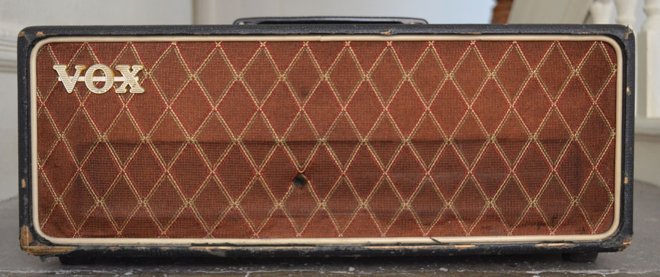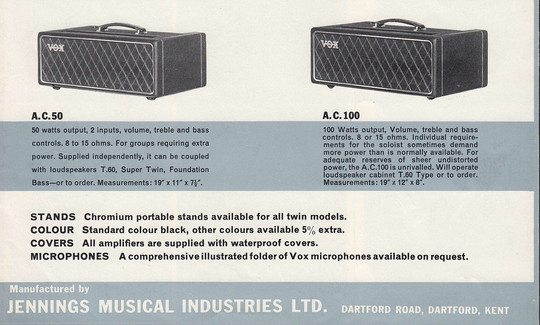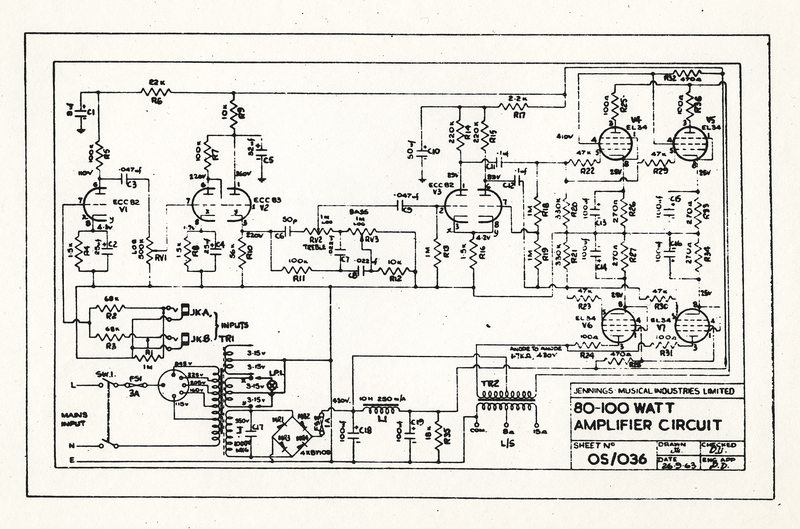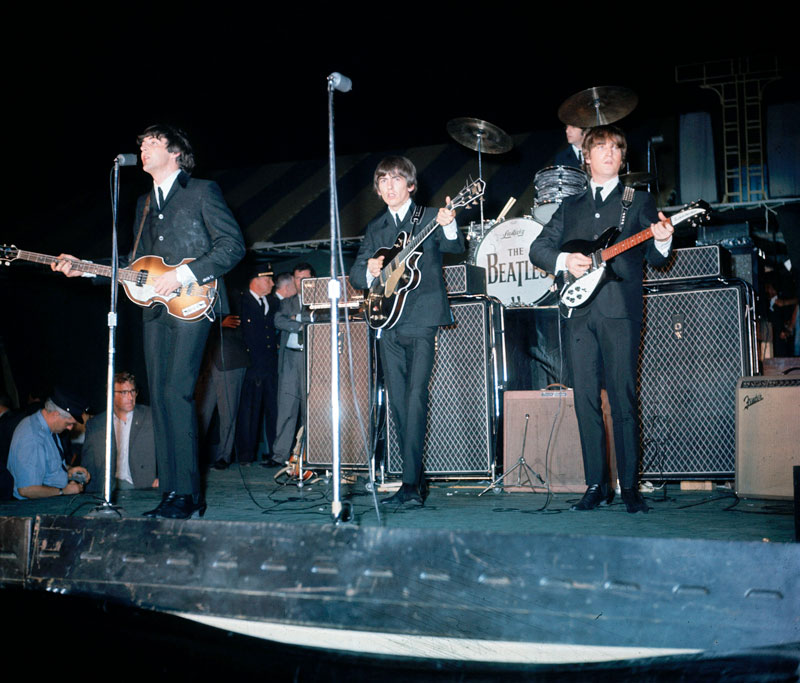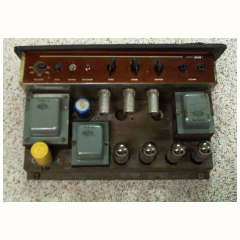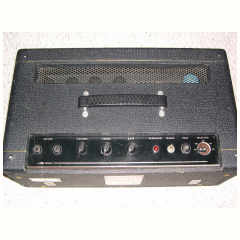Early Vox AC100 Amplifiers - the cathode biased AC80/100
INTRODUCTION
The earliest "thin-edged" amps
Early AC80/100s, distinguished by their "thin-edged" boxes (more on these below) and copper control panels, are rare birds. Probably only around 120 were made, perhaps beginning at serial number 100 or 101 - Paul McCartney's, the first, was actually 150B - and ending somewhere close to 220 - the production run, such as it was, extending from December 1963 to around October 1964. Serial number 221, which was sold on ebay in 2007, survives in its original thick-edged box.
See the details collected together on the pages here. Magazine adverts for the early (and later) amps are here.
A detail of Paul's amp on stage, Versailles, 14th January 1964. The AC80/100 had been issued to him in late December 1963.
A detail, inverted and slightly enlarged, from the high resolution file - 150 B on the plate.
A detail from the Vox catalogue of early 1964, either January or February, showing the new Vox AC50 and AC100. Thanks to Martin Kelly for the image.
The amps were assembled by Westrex, contractors for Vox, in North West London and transported from there to the factory at Dartford for boxing up. Westrex at the time also produced AC30s. For further details, see this page. The Vox AC50, on the other hand, was assembled by Triumph Electronics - more here.
Cathode bias
"Cathode bias" designates the mode by which the operating point (the "control bias") of the main power valves - the four EL34s - is set: in the case of the AC80/100 a resistor and capacitor network run to ground from the cathode of each valve, R26, R27, R33, R34 and C13-C16 on the schematic below. "Fixed bias" might have produced more power, as it did later for the "100W Amplifier" and AC100 mark 2, and less heat, but the sound and responsiveness of the cathode biased amp is far superior. Denney's judgement was spot on.
80-100 Watt Amplifier schematic. The only really observable deviation from the schematic in production - a sort of minor revision/non-revision - lies in the values of the preamp filter capacitors: 32uf instead of the 50uf marked, and 16uf instead of 8uf. Further AC100 schematics are available on this page.
An early AC80/100 chassis. The green-topped transformers were produced by Woden for JMI.

Above, the Westrex factory, 152 Coles Green Road, photographed in 1930. Picture from the britainfromabove website.
So far as one can tell amplifiers were produced in batches, and fitted out with boxes and so on at Dartford Road in batches. One can tell much from the ways in which back boards were arranged - see this page. When the time came for despatch, serial numbers would be noted in the sales ledger along with details of the recipient, whether individual, shop, or agent.
The boxes
The earliest boxes, as mentioned, were "thin-edged", the visible fore-edges being 1/4" thick compared to the 3/4" of the later "thick-edged" boxes. The cabinet maker was GlaRev, the company run by the flamboyant Henry Glass and his partner, Mr Revel. See also this page.
Thin-edged box: 19 inches wide.
Thick-edged box: 19 3/4 inches wide.
"Melody Maker" magazine, 12th September, 1964. The box of the amplifier section is thick-edged and its width given accordingly: 19 3/4 inches.
Brown-fronted amps (ie. with brown grille cloth) were made for use with bass cabinets; and after August 1964, some black-fronted were produced, generally for use with guitar cabs. So far only one thin-edged AC80/100 with original black cloth has come to light. But it is clear that perhaps a dozen or more were issued in this way in the latter part of 1964. The Beatles had five (new ones issued for the winter tour of Britain, October 1964; the Rolling Stones had two; and it is likely that other bands had them as well, though it is naturally difficult to tell from black and white photos.
Forest Hills (28th August 1964): Paul with his brown-fronted bass set, and John and Paul with all-black AC80/100s and Super Deluxe cabinets.
AC80/100s in thick-edged boxes (from November 1964)
One hundred and fifty or so thick-edged box AC80/100s followed those in thin-edged, running in terms of serial numbers from 221 to approximately 420, and perhaps a few after that, the dates in view being from late 1964 into the second quarter of 1965. The last amps may have overlapped with the new fixed bias "100W Amplifier", the immediate precursor of the AC100 Mk2 - more of which in due course.
Grille cloth was brown at first, but changed to black somewhere in the mid 200s. Control panels were copper, then black, then grey.
Amps in thick-edged boxes. From left to right, serial numbers 221, 276 and 320.
In terms of contractors, Westrex continued up to early 1965 - around serial no. 300, still using green Woden transformers; while probably at much the same time, production started up at Burndept Electronics in Erith. Burndept-made amps have chassis numbers stamped below the input jacks and Woden transformers with plain metal shrouds. Burndept also introduced the smaller upright choke, replacing the larger "laydown" unit of later amps, and necessitating a slight redesign of the chassis plinth.
The new boxes, more suitable for the weight of the amp, were produced by P. A. Glock, though Glass evidently began making them again in 1966 and 1967 (some are stamped "G-R"). As ever, the best source of information on these firms and their work for Vox (GlaRev for instance later produced cabinets for Hiwatt and Vamp) is Jim Elyea, "Vox Amplifiers", esp. pp. 136-137.
Note
Probably now, in 2017, fewer than two dozen thin-edged AC80/100s survive. Most stem from the end of the run - serial numbers 169 - 212. One possible explanation is that these were bought and paid for, and as such received more care and attention. A good number of those issued to bands must have come back to Vox, if they came back at all, in less than pristine condition.
In the video below, one can see what may be a thin-edged AC80/100 in Hessy's Music Shop in Liverpool in 1964:
Hessy's Music Shop in Liverpool seen in 1964, the amp visible in the background, esp. at around 0.47'
